

Injection molding is an efficient mass-manufacturing technique to create high-quality plastic parts and prototypes. It involves injecting molten resin into a pre-designed mold and then allowing it to cool and solidify.
Injection molding is largely applied for high production runs, and for such cases, steel, due to its durability, is applied for mold building. However, advances in tooling have established aluminum molds as a more cost-effective and viable solution for certain circumstances.
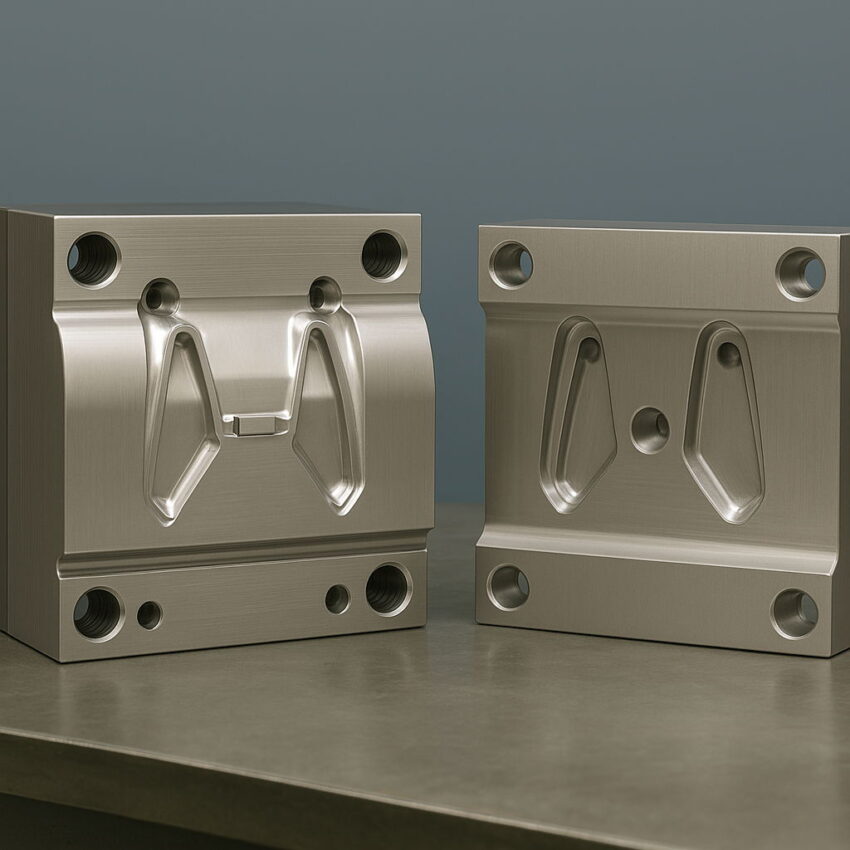
Aluminum injection molds are lightweight and demonstrate excellent thermal conductivity. Today, it’s a preferred choice for rapid prototyping and small-volume production runs. In this article, we discuss aluminum injection molds in detail.
Aluminum molds for injection molding are just like regular steel molds, but made out of aluminum. There are several reasons why they are very popular for rapid prototype molds and low volume production.
The lifespan of Aluminum molds is typically shorter, and they are thus well-suited for small volume production runs and prototyping. Typically, aluminum molds last between 3,000 to 10,000 cycles. However, the lifespan of Aluminum molds can be increased through surface treatments to enhance their corrosion and wear resistance, though this also increases costs.
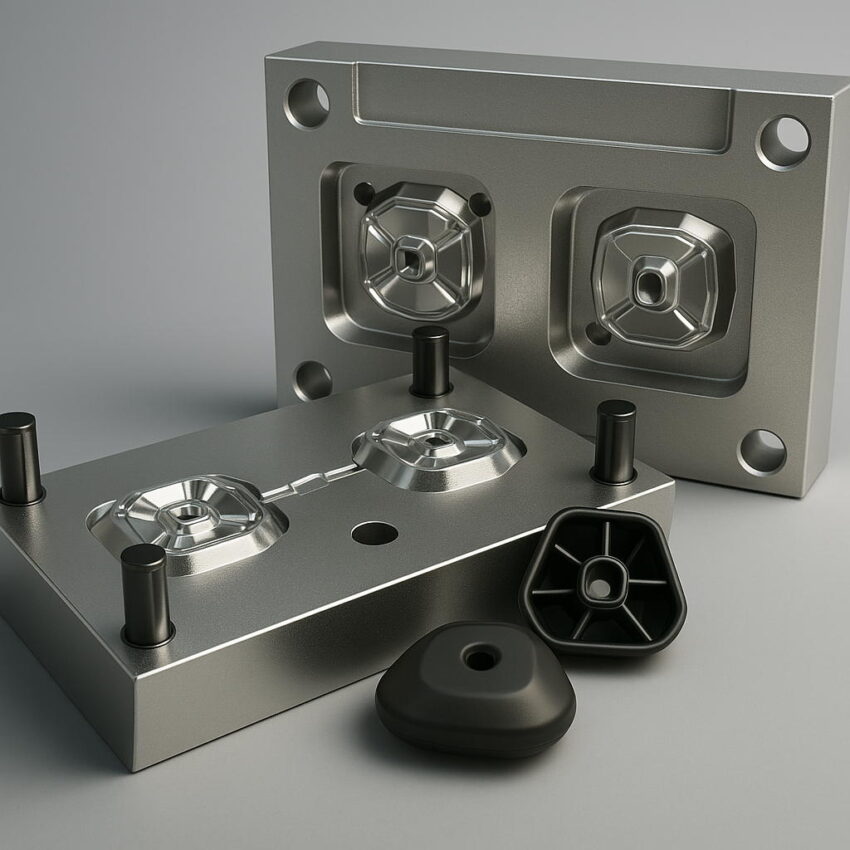
There are various types of aluminum alloys, and it is crucial to select the correct type of Aluminum alloy to meet the specific requirements of the mold. Let’s understand the most popular types of Aluminium alloy:
2024 aluminum alloy is a general-purpose alloy that’s suitable for structural foam and blow molding techniques. It has a higher copper content and is typically applied for manufacturing thin-walled molds.
6013 Aluminium alloy combines various properties such as corrosion resistance, strength, weldability, and moderate surface hardness. It demonstrates high strength and machines better than 6061 Aluminum alloy.
6061 Aluminum alloy has good machinability and high corrosion resistance. It’s well-suited for low-pressure applications such as large blow molds and low-volume injection molds.
7050 Aluminum alloy is applied extensively to create blow molds, structural foam molds, and injection molds. It’s characterized by its high strength and toughness.
7075 Aluminium alloy is a popular alloy suitable for prototype tooling and injection molds due to its excellent mechanical properties and machinability. It has
a high strength and is a high-hardness aluminum alloy.
Let’s understand some essential design considerations that are crucial for the efficiency of aluminum injection molds:
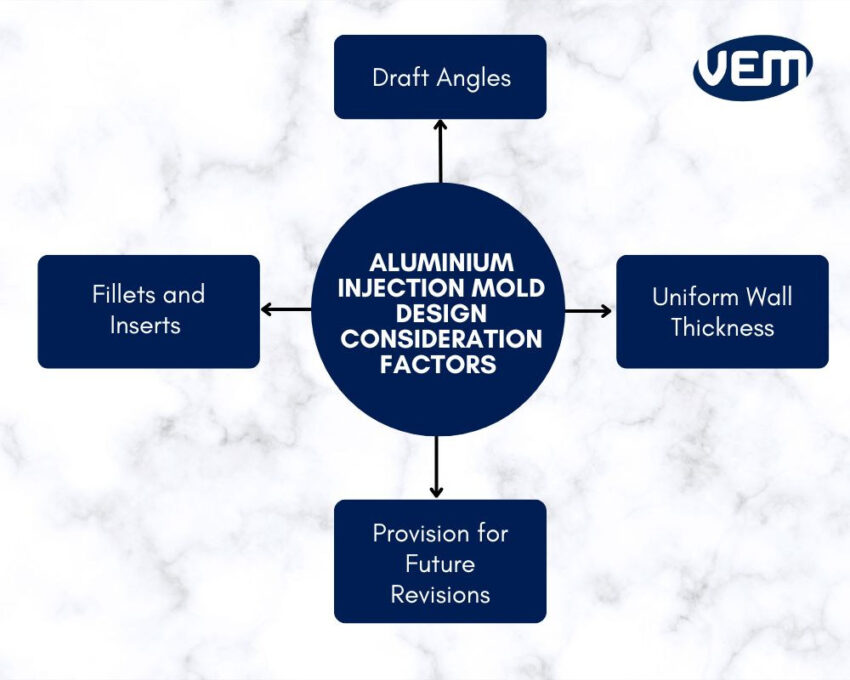
Adding draft to the aluminum injection mold improves the part moldability. If there is no draft, the parts may bend, break, or warp due to the molding stresses during the cooling phase.
The thinner sections of aluminum molds tend to solidify first, whereas the thicker sections take longer to solidify. Thus, the aluminum injection molds must be designed such that feed paths consider the solidification in both thin and thick areas uniformly.
You should also note that every resin has a recommended minimum wall thickness, and the thumb rule for the recommended wall thickness is between 1 and 3.5 mm / 0.040 and 0.140 in. It is crucial to follow these guidelines as it prevents warping and sinking during cooling. The following image enlists the popular thermoplastics with recommended wall thicknesses:
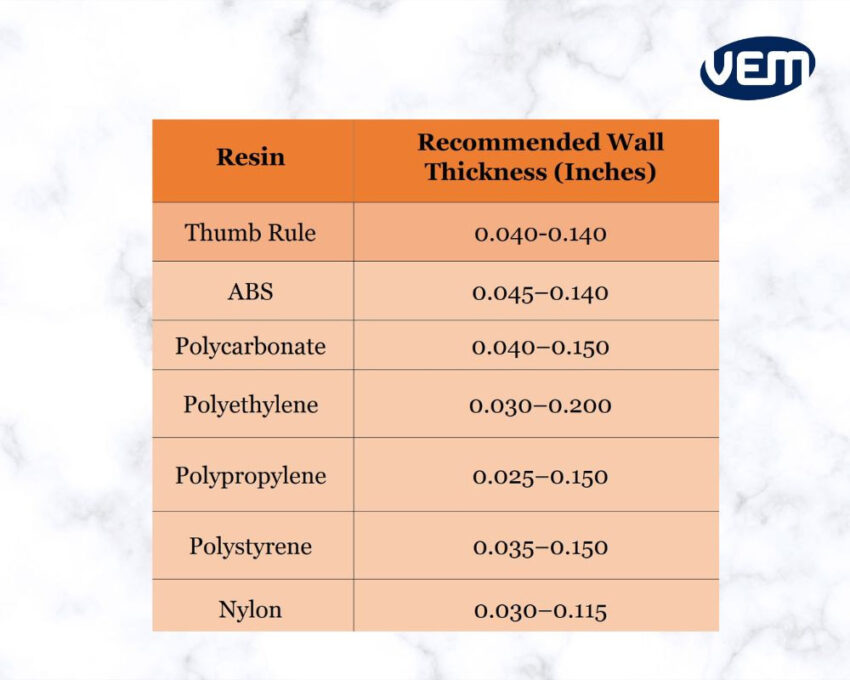
Sharp corners in molds create internal stresses that weaken the structural integrity of the mold. It is thus recommended that sharp corners be replaced with fillets and inserts in aluminum injection mold design.
It is advantageous to consider including a procedure for potential revisions and modifications. Such provisions increase the upfront costs, but if corrections or adjustments are anticipated, then they are more cost-effective in the long run.
Aluminium molds are not apt for high-volume production runs, but they do offer various benefits. Let’s understand these benefits further:
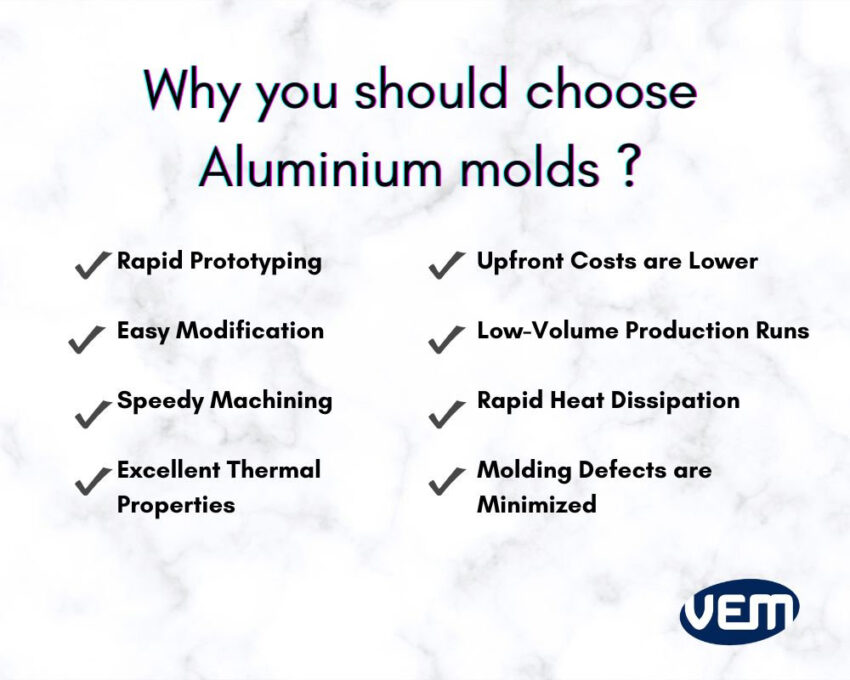
Comparatively, Aluminum molds are more cost-effective than other materials. Its overall value is dependent upon the usage of the mold, but if all other factors are constant, then the initial tool investment for Aluminum is typically lower.
Aluminum molds are apt for rapid prototyping processes as they are well-suited for creating small batches of prototypes and offer design flexibility. Aluminum is a softer material, which makes it easier to machine and thus enables an easy initial build. This particular agility of aluminum molds is especially beneficial for rapid prototyping as it can accelerate product development cycles.
Aluminium molds are apt for low-volume production runs due to lower upfront costs. Thus, they offer better value than other mold materials such as Steel.
In the case of steel, if there is damage or deformation, typically, the only solution is a new mold due to the extreme hardness of the steel. Since aluminum is a softer material, it’s easy to modify and repair the mold in case there is an error with the Aluminum mold.
Aluminum molds demonstrate excellent thermal conductivity, thus enabling rapid heat transfer during the injection molding process. This particular property of rapid thermal conductivity ensures consistent and efficient cooling, which further prevents excessive shrinkage and injection molding defects such as warping. Thus, aluminum molds are well-suited for applications where precise temperature control is crucial. It also reduces the cycle time, thereby enhancing the overall productivity in manufacturing.
Aluminum injection molds demonstrate an excellent and rapid heat dissipation, which means that they can heat and cool quickly. This particular property enhances mold production efficiency.
The excellent heat dissipation properties of aluminium injection molds enable injection molders to achieve uniform heating. This further minimizes the occurrence of various injection molding defects, such as sink marks, warpage, and voids.
Aluminum demonstrates an exceptional cutting speed, which further reduces the processing time. The excellent machining capabilities of Aluminum contribute to reduced cycle time.
While Aluminum molds for injection molding have several advantages, there are many limitations and challenges as well. Let’s understand these limitations further:
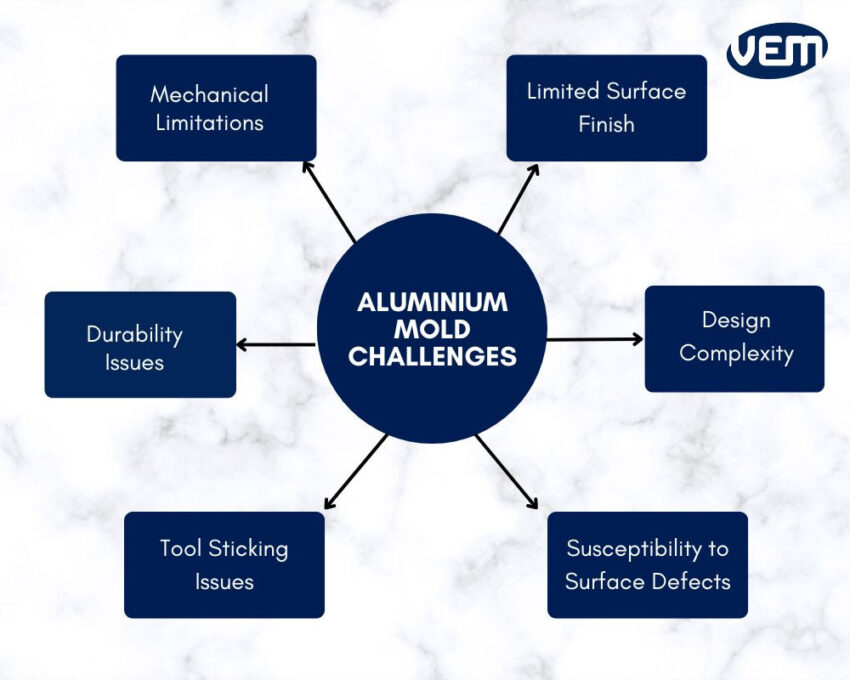
Comparatively, Aluminum molds are limited in terms of offering surface finish. This is particularly due to their low density, which directly affects the surface quality of the parts. Thus, aluminum molds aren’t suitable for applications where an immaculate finish is a priority. You should note that materials that have high density, such as steel, allow for various texture selections.
Aluminum demonstrates tool sticking issues as it tends to adhere to the tool. This further leads to the formation of built-up burrs.
Tool sticking issues have a significant impact on the machined surface’s smoothness. It also impacts the dimensional accuracy as such issues lead to alterations in the size and shape of the mold.
Comparatively, Aluminum molds are less durable. They are also less corrosion and wear resistant when compared to steel molds and are, thus, not apt for higher production volumes.
Compared to Steel, the mechanical properties of Aluminum are inferior, and it thus has various limitations. It cannot withstand high temperatures, pressure, and injection speed. Thus, Aluminum molds are best suited with high fluidity materials and at lower temperature and pressure requirements.
Aluminum injection molds are not suitable for complex parts as Aluminum is a softer material. If your project requires intricate detailing and has complex geometries, then Steel is a better choice. You should note that Aluminum molds cannot handle complex geometry because the metal is not as structurally strong as steel. It is subjected to deformation during the molding process.
Aluminum injection molds are prone to various types of surface defects, such as flashing, porosity, shrinkage, and warpage upon prolonged exposure. These, in turn, affect the product quality.
Aluminum injection molds enable manufacturers to create prototypes and conduct low production volume runs at a cost-effective price. It, however, requires expertise in terms of design, techniques, and an apt alloy selection.
VEM Tooling has built molds for over 20 years and has the expertise of manufacturing high-quality parts. We have design experts and experienced engineers who can help you build aluminum injection molds and other injection molding solutions.